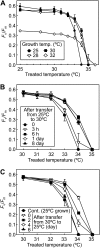Thermal acclimation of the symbiotic alga Symbiodinium spp. alleviates photobleaching under heat stress
- PMID: 23170037
- PMCID: PMC3532276
- DOI: 10.1104/pp.112.207480
Thermal acclimation of the symbiotic alga Symbiodinium spp. alleviates photobleaching under heat stress
Abstract
A moderate increase in seawater temperature causes coral bleaching, at least partially through photobleaching of the symbiotic algae Symbiodinium spp. Photobleaching of Symbiodinium spp. is primarily associated with the loss of light-harvesting proteins of photosystem II (PSII) and follows the inactivation of PSII under heat stress. Here, we examined the effect of increased growth temperature on the change in sensitivity of Symbiodinium spp. PSII inactivation and photobleaching under heat stress. When Symbiodinium spp. cells were grown at 25°C and 30°C, the thermal tolerance of PSII, measured by the thermal stability of the maximum quantum yield of PSII in darkness, was commonly enhanced in all six Symbiodinium spp. tested. In Symbiodinium sp. CCMP827, it took 6 h to acquire the maximum PSII thermal tolerance after transfer from 25°C to 30°C. The effect of increased growth temperature on the thermal tolerance of PSII was completely abolished by chloramphenicol, indicating that the acclimation mechanism of PSII is associated with the de novo synthesis of proteins. When CCMP827 cells were exposed to light at temperature ranging from 25°C to 35°C, the sensitivity of cells to both high temperature-induced photoinhibition and photobleaching was ameliorated by increased growth temperatures. These results demonstrate that thermal acclimation of Symbiodinium spp. helps to improve the thermal tolerance of PSII, resulting in reduced inactivation of PSII and algal photobleaching. These results suggest that whole-organism coral bleaching associated with algal photobleaching can be at least partially suppressed by the thermal acclimation of Symbiodinium spp. at higher growth temperatures.
Figures






Similar articles
-
Heat stress causes inhibition of the de novo synthesis of antenna proteins and photobleaching in cultured Symbiodinium.Proc Natl Acad Sci U S A. 2008 Mar 18;105(11):4203-8. doi: 10.1073/pnas.0708554105. Epub 2008 Mar 5. Proc Natl Acad Sci U S A. 2008. PMID: 18322010 Free PMC article.
-
Different thermal sensitivity of the repair of photodamaged photosynthetic machinery in cultured Symbiodinium species.Proc Natl Acad Sci U S A. 2009 Mar 3;106(9):3237-42. doi: 10.1073/pnas.0808363106. Epub 2009 Feb 6. Proc Natl Acad Sci U S A. 2009. PMID: 19202067 Free PMC article.
-
"Super-quenching" state protects Symbiodinium from thermal stress - Implications for coral bleaching.Biochim Biophys Acta. 2016 Jun;1857(6):840-7. doi: 10.1016/j.bbabio.2016.02.002. Epub 2016 Feb 8. Biochim Biophys Acta. 2016. PMID: 26869375
-
The ecotoxicological effects of Photosystem II herbicides on corals.Mar Pollut Bull. 2005;51(5-7):495-506. doi: 10.1016/j.marpolbul.2005.06.027. Epub 2005 Jul 27. Mar Pollut Bull. 2005. PMID: 16054161 Review.
-
Heat stress: an overview of molecular responses in photosynthesis.Photosynth Res. 2008 Oct-Dec;98(1-3):541-50. doi: 10.1007/s11120-008-9331-0. Epub 2008 Jul 22. Photosynth Res. 2008. PMID: 18649006 Review.
Cited by
-
Endosymbiont-Mediated Adaptive Responses to Stress in Holobionts.Results Probl Cell Differ. 2020;69:559-580. doi: 10.1007/978-3-030-51849-3_21. Results Probl Cell Differ. 2020. PMID: 33263887
-
Climate-driven shifts in algal-bacterial interaction of high-mountain lakes in two years spanning a decade.Sci Rep. 2018 Jul 6;8(1):10278. doi: 10.1038/s41598-018-28543-2. Sci Rep. 2018. PMID: 29980756 Free PMC article.
-
Transcriptomic Analysis of Thermally Stressed Symbiodinium Reveals Differential Expression of Stress and Metabolism Genes.Front Plant Sci. 2017 Feb 28;8:271. doi: 10.3389/fpls.2017.00271. eCollection 2017. Front Plant Sci. 2017. PMID: 28293249 Free PMC article.
-
Diverse responses of Symbiodinium types to menthol and DCMU treatment.PeerJ. 2017 Oct 2;5:e3843. doi: 10.7717/peerj.3843. eCollection 2017. PeerJ. 2017. PMID: 29018600 Free PMC article.
-
Symbiodinium genomes reveal adaptive evolution of functions related to coral-dinoflagellate symbiosis.Commun Biol. 2018 Jul 17;1:95. doi: 10.1038/s42003-018-0098-3. eCollection 2018. Commun Biol. 2018. PMID: 30271976 Free PMC article.
References
-
- Aro EM, Virgin I, Andersson B. (1993) Photoinhibition of photosystem II: inactivation, protein damage and turnover. Biochim Biophys Acta 1143: 113–134 - PubMed
-
- Baker AC. (2001) Reef corals bleach to survive change. Nature 411: 765–766 - PubMed
-
- Baker AC. (2003) Flexibility and specificity in coral-algal symbiosis: diversity, ecology, and biogeography of Symbiodinium. Annu Rev Ecol Evol Syst 34: 661–689
-
- Baker AC, Starger CJ, McClanahan TR, Glynn PW. (2004) Coral reefs: corals’ adaptive response to climate change. Nature 430: 741. - PubMed
Publication types
MeSH terms
Substances
LinkOut - more resources
Full Text Sources
Miscellaneous

